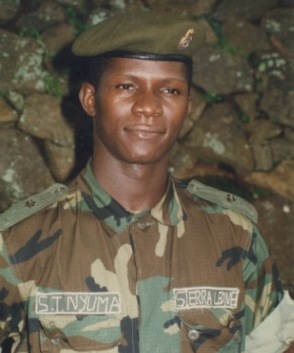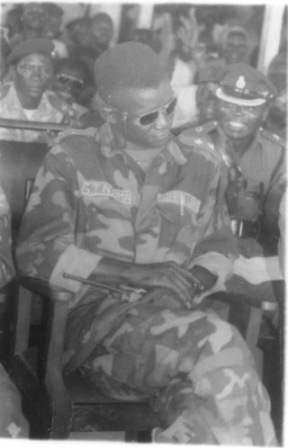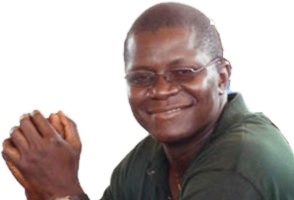Tom Nyuma and the making of NPRC: In Memoriam to “Ranger” Part I
It is always tough to write an obituary of a young person who dies too soon. I find myself in that position writing this obituary of Tom Nyuma, a young man who died at 42 years old on January 26, 2014. But what I write here is less about Tom the dead, and more about what he did when he lived.
For those who fought with him—in Liberia when he was among the first group of Sierra Leonean soldiers sent under ECOMOG in 1990, and then in Sierra Leone where he gained a name for himself for becoming, first as a non-commissioned officer and later as a commissioned officer, one of the audacious and daring soldiers to fight the RUF rebels of Foday Sankoh— Tom was a courageous and fearless soldier, perhaps one of the bravest and ingenuous in the recent, if not the entire, history of the Sierra Leone military. The reputation of Tom as a warrior was reinforced when he elected, after the 1992 coup which he masterminded as I will show shortly, to be a soldier at the war front rather than become a military bureaucrat in Freetown.
I never served in the military, but Tom, who I had known before he was a soldier, was always enamored of military life. He was passionate about it, romanticized it, and liked its ruggedness, adventurism and machismo-ism.
I had known him when I was a student at Fourah Bay College (FBC) and he was a student at The Prince of Wales School in Freetown. When I became a Research/Teaching Assistant at FBC, Tom’s father, Pa Joe Nyuma who worked at FBC’s Plant Yard, took him to me and asked that I mentor his son so that he could enter college. So I became, in the late 1980s, Tom’s personal tutor when he was preparing to retake his O’ Level exams. But it was evident during his lessons with me that he was not interested in the exams or in going to college. He told me often that he wanted to be a soldier, because he believed that was his calling, and, once in the military, to overthrow the APC government, because that was his destiny.
So when Tom joined the Sierra Leone military at the dawn of the 1990s, he believed his calling had been answered. I never took seriously his bluff about the “destiny” part. How mistaken I was!
When he took the nom-de-guerre “Ranger”, as soon as he was enlisted, it solidified how he imagined himself as a soldier. He named himself after the United States Army Rangers—that elite, legendary fighting force, whom he idolized and revered. He admired their tactical skills in special security and fighting missions; scouting and reconnoitering strategies; special operations and combat readiness; flexibility and agility and the use of lethal force when confronted with the enemy. Of course, desiring to be a ranger-like soldier in the Sierra Leone military was just that—a pipe dream. But that did not stop Tom from modeling his young military career on these qualities. Although he had fought the rebels in Kailahun when he was still a non-commissioned officer after he returned from Liberia, it was when he became a 2nd Lieutenant, and was sent to Pujehun, that his fighting audacity and bravery started to reach the ears of his military superiors, the APC political establishment, and the Sierra Leoneans who were following the progress of the war with intense trepidation. Tom was convinced that the Sierra Leone Military was never going to dislodge the RUF rebels from Sierra Leone territory through conventional means, but only by “ranger-type” strategies. Embarking on stunning, death-defying missions into rebel territories that put his life and those of the men fighting with him at the utmost risk, Tom’s reputation as a gallant warrior spread through the nation like the proverbial harmattan fire. Such valiancy would eventually make him to lead the coup that overthrew the Momoh government.
Tom Nyuma initiated the plans and executed the strategies that led to the NPRC coup. The existence and survival of the military junta would not have been possible without him. Along with his trusted comrade, Lieutenant Sahr Sandy, who was killed on the day of the coup, Tom directed every detail and movement that led to the coup’s success. Had Sandy (who was Tom’s senior in rank) not been killed on that day, he would have ended up becoming the leader of the NPRC. Tom was so powerful, and the undisputed “owner” of the coup, that two major leadership changes that occurred during the NPRC—first, the elimination of SAJ Musa who was the Deputy Chairman of the regime, and second, the palace coup against Valentine Strasser who was the Chairman of the junta—were approved and implemented by him.
To understand how Tom came by the resources that enabled him and his comrades to undertake the coup is first of all to know what led him to those resources in the first place. From the moment the rebel incursion started in Sierra Leone in 1991, there was the undisputed view among many of the soldiers who were fighting it, and the general population at large, that President Momoh was not committed in prosecuting the war. For the soldiers, one way the government blatantly manifested this was to deny them the lethal weapons they needed to fight the rebels. The view was that the government feared that such weapons in the hands of the “wrong” soldiers might be used against it. And the government’s fear was not without basis, as subsequent events would demonstrate.
Thus started a process of “selective” arming by the government and its military leaders who made available new and/or lethal weapons to their “loyal” soldiers. In fact, this policy was so egregious that, for instance, when the APC in the early period of the war bought new AK 47s and Rocket Propelled Grenades (RPGs) to match those being used by the RUF rebels, the government gave such weapons to the soldiers stationed in Freetown who were protecting Momoh and his government and to a very select group of “loyal” soldiers at the war zones. Moral among those fighting the war was palpably low; the resources they needed to fight the war were at times non-existent. These were exacerbated when some soldiers started believing that the APC government had planted death squads in the war zones to eliminate the gallant soldiers fighting the war. Their suspicions were concretized when Captain Prince Benjamin-Hirsch—whose intrepid efforts in fighting the war in its early stages were unquestionable—was killed in an ambush in a friendly territory in Kailahun. Ben-Hirsch inspired some of the young officers who would later join the ranks of the coupists
The government’s “selective” arming was to work to the advantage of Tom, who was by then stationed at Pujehun where his brave and adventurous campaigns against the rebels were now part of the war narrative. News of his strategies that outwitted the rebels and beat them at their own tactics continued to reach the military leaders and politicians in Freetown. Tom made the case to his military seniors that he could accomplish more if only he had the weapons he needed, but the military establishment was suspicious and did not want to trust him with more sophisticated weapons.
However, Tom capitalized on his popularity and bravery at the war front to by-pass the military structure that would not arm his fighting men. He did so by going through the political leadership at State House. Having grown up at the Lower Faculty Flats at FBC with his Father, Pa Joe Nyuma, Tom was a neighbor of the late Dr. A. K. Turay (commonly known as AKT, or Mister), who was a Professor of Linguistics at the College but was to become the Minister of State for presidential Affairs to President Momoh. As neighbors, Tom had been the “small boy” who ran errands for AKT. Using this contact, Tom became a trusted ally of State House and a beneficiary of the government’s “selective” arming tactics.
From that point, Tom started receiving robust military support that came not from military headquarters but from State House. Over the many months leading to the coup, Tom would come to State House every other week to pick up weapons and food for his fighting unit. And the Pujeun Battalion, now known as the “Cobra” Battalion, achieved spectacular successes against the rebels. In fact this led to fierce rivalry with the Eastern Battalion, now known as the “Tiger Battalion”—a rivalry that nearly destroyed the military after the coup. With their continued success came more military weapons, and with Tom’s appeal the “Cobra” Battalion ended up getting one of the prized weapons in the Sierra Leone arsenal at the time—a mobile Anti-Air (AA) Craft gun, I believe from Soviet-era models. There were, I believe, only two in the nation’s arsenal and both were based in Freetown before one was sent to Pujehun.
To understand the NPRC coup is to know about this AA gun, and how it was stealthily moved from Pujehun to Freetown.
by Patrick S. Bernard
Stay with Sierra Express Media, for your trusted place in news!
© 2014, https:. All rights reserved.






Sheik
/
I have never read a Sierra Leone article so well written. Better than the York Times
Tom was a brave soldier. He defended Kenema for years. I know him very well
8th February 2014